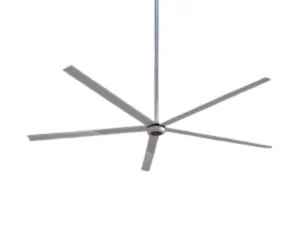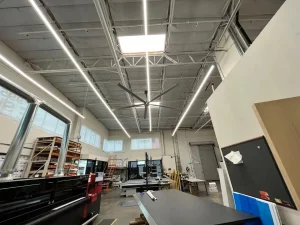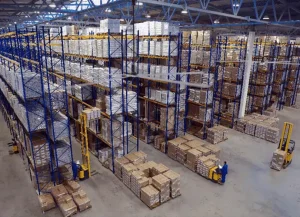Large buildings—like factories, sports halls, or a bustling warehouse—often deal with stuffy, aire caliente that undermines comfort and efficiency. This issue can escalate operational costs, hurting overall performance. Yet, there’s a game-changing answer: implementing an Ventilador HVLS system can optimize airflow, reducir la energía usage, and raise occupant satisfaction.
HVLS stands for high-volume, low-speed. It refers to a tipo de ventilador that moves grandes volúmenes de aire at a gentle rotation, boosting ventilación and keeping spaces Frío without excessive power. By complementing an Sistema HVAC, un Ventilador HVLS evens out temperatures, curbs consumo de energía, and enhances calidad del aire. It’s the HVAC system’s best friend for cost-effective comfort.

ventiladores hvls
Un Ventilador HVLS—which stands for high-volume, baja velocidad—is specially designed to handle large volumes of indoor air. Instead of spinning quickly like ventiladores de alta velocidad, it rotates slowly, pushing significant volumes of air with each turn of its larger diameter fans. This gentle yet expansive coverage is a principal advantage of hvls fans in large buildings.
En breve, hvls stands for precisely what these devices do: handle grandes volúmenes de aire en un baja velocidad rotation. The concept is straightforward yet powerful. Because an HVLS fan varies in diameter—some can exceed 24 pies—the slow, wide-spread movement provides a uniform breeze over massive floor areas. This effect is vastly different from the localized, forceful gusts produced by smaller, high-speed ceiling fans.
Mientras fans have been used in homes and small offices for centuries, industrial and commercial buildings faced challenges in distributing movimiento del aire eficazmente. Regular abanicos tradicionales typically rely on smaller blades spinning rapidly, forcing them to cover less area. HVLS redefines that approach by offering a calm yet extensive breeze. For places like a depósito or a school gym, that difference translates into real energy and cost benefits—especially when we aim to Frío large, open spaces.
A well-managed Sistema HVAC can keep a building comfortable—but often at a high operating expense. Ventiladores de techo HVLS can mitigate that burden by driving uniform temperatures from top to bottom, making them your hvac system’s best friend. Porque aire caliente typically rises to the ceiling, hot spots form above occupant level. HVLS technology helps pull those layers down, distributing them more evenly, which means Los fans ayudan you reduce heating or cooling loads.
Although hvac systems provide temperature control, they may struggle with large, open areas or spaces with tall ceilings. By mixing the air, HVLS solutions reduce temperature stratification, so your heating or cooling equipment doesn’t overcompensate. This synergy helps keep your building’s climate stable and fosters a ambiente confortable for employees or visitors.
Los aficionados se mueven air—this is fundamental. But in big places, the distribution of that air can make all the difference. HVLS fans push airflow outward from the fan’s center at a mild Velocidad del aire, ensuring it gently falls toward the floor, rather than blasting a single zone. This balanced approach means fewer cold or hot pockets, making the entire space more pleasant.
Many businesses assume they need powerful AC units to handle large square footage. However, an HVLS approach can complement or, in certain climates, partially replace mechanical cooling, helping you reducir la energía consumption. So whether you manage a 50,000-square-foot packaging plant or a 10,000-square-foot school gym, an HVLS solution can support your existing hvac systems with minimal fuss.
If you’re looking to Frío effectively, not all devices operate the same. An Ventilador HVLS is a unique tipo de ventilador because it relies on large, slow-turning blades to generate broad flujo de aire. This approach contrasts with smaller-diameter, faster-spinning fans that cause localized breezes.
HVLS fans can move a massive cantidad de aire. Instead of churning it at high RPM, they revolve steadily, which leads to reduced noise, fewer distracting drafts, and more consistent coverage. This dynamic fosters a noticeable efecto refrescante—akin to a gentle breeze across your entire interior. Not only does it feel refreshing, but it also helps with temperature regulation.
Consider this: a single HVLS fan with a diameter of up to 24 feet in diameter can outperform 10 to 20 floor fans in a spacious environment. That alone underscores the technology’s efficiency. By adopting HVLS, you can skip cluttering your facility with countless ventiladores más pequeños. Instead, you get a sleek overhead solution that improves calidad del aire y comodidad de los ocupantes.
Imagine a large school cafeteria or an indoor sports center. Before, the building might have used numerous pedestal or box fans to stay Frío in the summer. Each of those used electricity while creating a cluttered walkway. Now, by installing one hvls fan overhead, you can keep that space open, safe, and comfortable, leading to better occupant experiences.
Yes, but let’s clarify. A typical household ventilador de techo is different from an ventilador de techo industrial designed on HVLS principles. While a standard overhead spinner might handle a living room, HVLS technology tackles entire factories or enormous gymnasiums, delivering the Beneficios de los ventiladores HVLS on a massive scale.
Los ventiladores HVLS también son called ventiladores industriales because they often operate in rigorous conditions, like distribution centers, manufacturing lines, or even airplane hangars. They work quietly at Baja velocidad, distributing air gently instead of producing an aggressive wind tunnel. So if you require consistent ventilation and cooling in a large facility, a specialized HVLS approach is ideal.
When you stand under an HVLS system, you immediately feel a soothing breeze, or cooling sensation. That breeze reduces perceived heat and ensures comodidad del trabajador, especially in warmer months. The combination of large diameter, slow rotation, and wide coverage means the entire environment becomes balanced. And as the fans run, building managers often see fewer complaints about stuffiness.
Below is a small table comparing abanicos tradicionales versus HVLS for industrial ceilings:
| Comparison | Abanicos tradicionales | Ventilador HVLS |
|---|---|---|
| Blade Size | 2-6 feet | 8-24 feet (or more) |
| Movimiento del aire | Localized, quick bursts | Broad, gentle coverage |
| Eficiencia energética | Moderado | Alto |
| Nivel de ruido | Often noticeable | Typically quieter |
| Installation | Multiple units needed | Fewer units, strategic placement |

HVLS Fans for Industrial Demands
Excessive indoor heat can hinder productividad. Individuals feel sluggish, dehydrated, and uncomfortable, which often leads to frequent breaks or decreased morale. By using an hvls fan, managers can alleviate these issues and sustain higher efficiency.
When staff members stay cool, they can focus on tasks without constant discomfort. HVLS fans create gentle breezes that keep the environment inviting, ensuring people remain alert and enthusiastic. Over time, better comfort correlates with fewer heat-related incidents or accidents.
Stagnant air fosters microbial growth, unpleasant odors, and general fatigue. Keeping the environment well-circulated helps employees breathe easier. By preventing warm pockets, you reduce the risk of workers feeling exhausted, thus sustaining a safer, healthier atmosphere.
Here is a basic comparison chart on how fans work Para mejorar productividad:
| Factor | Without HVLS | With HVLS Fan |
|---|---|---|
| Temperature Consistency | Uneven, hot spots | More uniform, balanced |
| Worker Concentration | Decreased due to heat | Improved comfort, better focus |
| Calidad del aire | Potential stagnation | Constant circulation, fresher air |
| Employee Satisfaction | Frequent complaints | Positive feedback, fewer breaks |
Absolutely. HVLS solutions complement Calefacción y refrigeración systems by reorganizing how air circulates, especially in spaces with lofty ceilings. When los fans se mueven air gently, they maintain an effective temperature from floor to ceiling.
During colder months, warm air accumulates above occupant height. This phenomenon can inflate heating expenses because your system works overtime to heat occupant areas that still feel chilly. By employing HVLS, that heat is pushed or pulled toward the floor, so you can turn down the furnace a bit. Over the course of a year, the cost difference becomes substantial.
During summer, these fans create a mild breeze that speeds evaporation on the skin. Even a fan moving air at 3 a 5 mph fosters a comfortable environment. This airflow means people feel a few degrees cooler than the ambient temperature, known as the “efecto refrescante.” The result is less strain on cooling equipment, or in some cases, you may skip mechanical AC altogether if the climate is moderate.
One automotive parts facility installed a single hvls fan in its largest assembly area, around 20,000 square feet. The results were immediate: employees commented that the “breeze from an hvls fan felt like stepping outside on a mild day.” Over the next quarter, the facility logged lower climate-control expenses, recouping part of the fan’s investment quickly.
Ahorro de energía arise from distributing air efficiently, thereby eliminating the need for multiple smaller devices or forcing your AC system into overdrive. Although an HVLS fan varies in size, the operating speed is so gentle that electricity usage remains moderate.
At first glance, you might assume a bigger fan devours more power. Interestingly, that’s not always the case for HVLS. Although the drive a fan increases with diameter to some degree, the slower RPM offsets that effect. So you can enjoy consistent coverage without spiking your power bills. Over time, that translates into thousands in savings—an Eficiencia energética approach indeed.
The actual power draw of an HVLS fan varies by model, blade design, and usage patterns. However, owners report that the gentle daily usage costs far less than relying on varios fans or robust mechanical cooling day in, day out. Coupled with the synergy they offer existing AC setups, it’s clear why these devices are praised as the use hvls fans approach for cost-effectiveness.
In large distribution hubs, installing HVLS can eliminate the need for an air conditioner to run on max. The fans create a mild Frío breeze that employees find sufficient for comfort, cutting cooling overhead drastically. Meanwhile, your heating demands also shrink in winter, because these fans shuffle the hot layers near the roof back into occupant zones, reducing the burden on the heating system.
In some scenarios, managers wonder if they should pick multiple smaller diameter fans or a single HVLS approach. Here is a quick reference table that compares potential coverage:
| Option | Number of Fans | Approx Coverage | Projected Energy Use |
|---|---|---|---|
| Smaller Diameter Fans | 5 – 10 | Limited circle each | Higher due to quantity |
| Single HVLS Fan | 1 | Wide, uniform area | Moderate, lower overall |
Many see that one HVLS device can simplify installations, reduce wiring and motor costs, and yield a more coherent movimiento del aire pattern.
A busy depósito faces multiple ventilation challenges—loading bays stand open, forklift traffic stirs dust, and the building’s high ceilings trap heat. By employing HVLS solutions, you effectively tackle these issues in one go.
Porque hvls fans push big volumes outward, a facility’s air gets recirculated consistently. In tall racked aisles, the fans move air further down rack levels, so employees picking items on higher shelves don’t sweat while those on the ground freeze. The gentle downward push ensures the entire environment remains stable and welcoming.
Aside from balancing temperatures, HVLS fosters better calidad del aire, clearing stagnant pockets that might encourage mold or stale smells. Additionally, the presence of a mild breeze can keep employees more alert—truly an advantage of hvls fans for both safety and efficiency. The comfortable, breezy atmosphere fosters fewer breaks and helps maintain productivity metrics.
I recall touring a massive storage building that had high-level condensation problems in the upper racks. By installing ventiladores hvls is their ability to gently push moist, warm pockets downward, preventing condensation from forming. This simple change dramatically cut product damage and improved the environment for staff.

Ventiladores HVLS en un gran almacén
Finding the El fan tiene razón for a certain facility depends on multiple factors: square footage, ceiling heights, occupant density, and local climate. While HVLS solutions excel in broad, open environments, some buildings may incorporate a mix of overhead HVLS and smaller floor fans to handle niche corners.
En conclusión, Los ventiladores HVLS proporcionan a powerful solution to handle Calefacción y refrigeración challenges across large areas. The use of hvls fans stands out due to their broad coverage, synergy with existing hvac systems, and minimal electricity usage. Because HVLS fans are a high performer in balancing indoor climates, they effectively reduce hot and cold stratifications that hamper occupant experiences.
By distributing grandes volúmenes de aire en un Baja velocidad, these solutions create a gentle yet pervasive breeze that fosters a stable effective temperature throughout. Whether you run a sprawling warehouse, an expansive gym, or a high-ceiling commercial facility, adopting HVLS can cut operating costs, drive occupant satisfaction, and boost comodidad del trabajador y productividad.
If you’re ready to harness this technology, connect with fan suppliers who specialize in HVLS designs. By leveraging ventilador de techo industrial models with advanced fan controls, you’ll discover how these ventiladores industriales can transform your building into a truly Eficiencia energética, ambiente confortable. So if you find yourself asking, “Which El fan tiene razón for me?” the answer might lie in the slow yet impactful spin of an Ventilador HVLS.
Why are HVLS fans more energy efficient?
They operate at a Baja velocidad but move significant volumes of air, so fewer fans are needed to achieve effective circulation. Also, their slower motors reduce overall consumo de energía while providing robust coverage.
Can HVLS fans replace air conditioning?
While they Frío effectively through enhanced movimiento del aire, they don’t refrigerate the air like AC. Still, in mild climates or certain seasons, they can reduce reliance on AC. In hotter regions, pairing them with an Sistema HVAC can slash operating costs.
How fast is a fan moving air at 3 mph or 5 mph?
That air velocity feels like a gentle breeze—enough to create a efecto refrescante on the skin without being disruptive. Precisely because these fans run at moderate speed, they cover broader areas quietly.
Is a high-speed ceiling fan better than HVLS for large rooms?
Not necessarily. High-speed ceiling fans often create powerful but localized gusts. In contrast, HVLS solutions rely on bigger blades and slower turns to reach more of the space comprehensively. Over time, this translates to better comfort and lower energy usage.
Why do some HVLS fans measure 24 feet in diameter?
24 pies is a common spec for extensive commercial or industrial floors. At that size, the fan can produce gentle, wide-reaching flujo de aire, eliminating the need for multiple smaller devices that might be less efficient collectively.
Embrace the potential of HVLS technology to reducir la energía costs, improve occupant well-being, and streamline Calefacción y refrigeración demands. In an era where operational efficiency and occupant satisfaction take center stage, these robust, baja velocidad fans promise a balanced environment for any overall building layout—all thanks to the calm yet extensive coverage of a well-designed Ventilador HVLS.

Hola, soy yo Michael Danielsson, CEO de Vindus Fans, con más de 15 años de experiencia en la industria de la ingeniería y el diseño. Estoy aquí para compartir lo que he aprendido. Si tienes alguna pregunta, no dudes en contactarme en cualquier momento. ¡Crezcamos juntos!